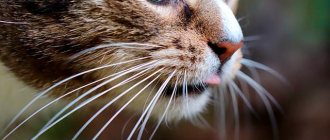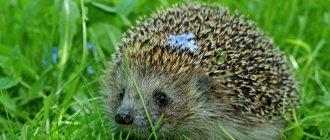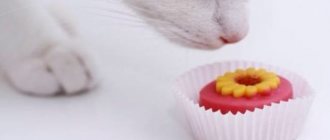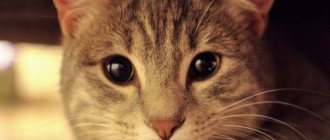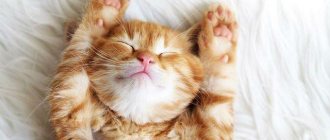6157Administration
1
Hearing is a cat's most important tool for survival in the wild. The structure of a cat's ear is somewhat different from a human's. The animal perceives a much larger number of sounds simultaneously, and is able to determine the distance of objects through hearing. Cats' ears have muscles that can move independently of each other. This allows cats to control their ears like locators, turning them in different directions and picking up any signals around them.
Cleaning a cat's ears - step-by-step instructions
- Position the cat so that it is positioned sideways to you and sit it on your lap. If necessary, grab it by the withers or wrap it in a towel;
- Carefully turn out the auricle and inspect its contents for the presence of dirt, inflammation and crusts;
- If you notice heavy discharge, take a swab and dip it in the chlorhexedine solution. Squeeze it out and walk along the inside of the ear, without pressing or going deep inside; Gently lift the skin at the base to blot the surface of the ear with the swab
- If more wax has accumulated in your pet's ears, drop saline solution into the ear canal and massage it so that the liquid flows inside. After instillation, hold the cat for ten minutes to ensure that the solution has reached its target;
- If the solution used is in a bottle, then lower its tip two to three millimeters into the ear canal and squeeze out the required number of drops;
- When using cotton swabs, do not try to push them in as far as possible. In the inner ear, as a rule, wax does not accumulate due to the presence of the eardrum, therefore there is nothing special to clean “in depth”;
- When working with cotton swabs, make sure that your movements are directed outward and not inward, otherwise you will only push the sulfur deeper, from where it will be even more difficult to get it out;
Movements made with a cotton swab must be carried out according to strict rules - When you are sure that the drops have successfully passed inside, wipe the animal's ears with a towel and reward him with a treat for his outstanding achievements.
Keep in mind that too frequent cleaning of your pet's ears leads to damage to the ear microflora, which is also fraught with various diseases. The frequency of cleanings depends on the breed and should be discussed with your veterinarian.
By the way! Hairless cats produce more earwax and require frequent cleaning.
What is the sclera and why is it needed?
Sclera
is a dense, opaque part of the outer membrane of the eye. It is formed by collagen fibers, giving it density.
The sclera occupies most of the fibrous membrane of the eyeball. In different areas its thickness ranges from 0.3 mm to 1 mm.
The main functions of the sclera are support for the internal and external structures of the visual organ, protection from adverse factors, and protection of the retina from excess light. It also ensures the outflow of aqueous humor and regulates intraocular pressure.
How the structure of the eyes changes with visual impairment
Many pathologies lead to changes in the structure of the visual organ, which can be detected by an experienced ophthalmologist
:
- with myopia (myopia), the eyeball enlarges and takes on an elongated shape;
- with farsightedness (hypermetropia), the organ of vision becomes shortened;
- keratoconus causes thinning of the cornea, giving it a cone shape;
- cataracts, which often occur in old age, provoke clouding of the naturally transparent lens;
- retinopathy is accompanied by damage to the vessels of the retina, its “drying out”.
What is anatomy?
Anatomy is a branch of science devoted to the study of the structure of the bodies of various creatures. Anatomy helps to establish the common features inherent in a particular species of animal. This science studies the external characteristics of species, the location of internal organs relative to each other, and clarifies their significance and functions.
Anatomy includes the following areas of science:
- osteology, which studies bone structures;
- myology, which studies the structure of muscle fibers, the location of muscles and the characteristics of their work;
- syndesmology, which studies the elements connecting parts of the skeleton;
- angiology, which studies blood vessels, lymphatic and circulatory systems;
- neurology, aimed at studying the functions of nodes and parts of the nervous system;
- splanchnology, systematizing knowledge about the structure of the respiratory, digestive, excretory and reproductive organs;
- endocrinology, explaining the significance of the endocrine glands;
- aesthesiology, which studies the functioning of the senses.
These scientific disciplines make it possible to trace how the formation of the most important systems occurs, as well as to establish their interrelationships. By studying the anatomy of a cat, you can find out what distinguishes it from other mammals. Anatomical knowledge allows us to understand the purpose of certain structures of the body.
Blink rate
How often a cat blinks depends on its internal state and the health of its eye system. Why does a cat rarely blink its outer eyelids?
The answer is simple: the internal nictitating membrane moves much faster. Scientific research data indicate that the speed of movement of the third eyelid is so high that a person simply does not have time to notice the blinking of the membrane.
Is it possible to notice how this happens?
The shape of the nictitating membrane is similar to a crescent. If a speck gets into the eye, it is immediately swept away by the edge of the inner eyelid.
The inner eyelid moves due to contractions of smooth and striated muscle fibers; This mechanism is controlled by the sympathetic nervous system. The elastic film stretches easily and can cover the entire eye. In a calm state, it hides in the corner of the eye and is almost invisible.
What does slow blinking mean?
Eyelid movements help cats communicate with their relatives and with their owners. Wanting to dominate or drive away an opponent, the cat looks at him intently with a threat, without blinking for a long time.
By blinking slowly, the animal sometimes tries to “hypnotize” the enemy.
If a cat looks into the eyes of its owner and slowly closes its eyes, this is a sign of love, trust and a desire to communicate. The animal shows that it is not afraid of you and does not expect dangerous actions on your part. This blinking is called a cat kiss. In response, it is better for a person to slowly cover his eyelids.
How often should I clean?
The frequency depends on the breed of the animal and the intensity of sulfur formation. The ears of short-haired and hairless breeds get dirty most quickly: various types of Sphynxes, Orientals, Siamese, Abyssinian cats. In animals of fluffy and long-haired breeds (Siberian, Turkish Van, Angora, Persian), long hairs serve as a natural filter against pollution.
Affects the frequency of ear cleaning and the animal’s lifestyle. If the cat is young, healthy, and lives in a clean room, then there is no need for frequent procedures. If your pet goes outside freely and likes to roll around in the dust, you will have to clean his ears much more often. Dust and earwax are fertile ground for bacteria and ear mites.
The frequency of care procedures is as follows:
- Superficial examination of the ears - daily.
- Thorough examination of the auricle - 2 times a week.
- Hygienic cleaning - as needed, on average 2-3 times a month.
Alarming signs are the appearance of age spots on the ears, rashes, growths or bumps. This is a signal that your pet is sick, and you should not hesitate to visit the veterinary clinic. If your cat becomes restless, meows pitifully, or shakes its head, take your pet to the veterinarian. The cat may have otitis media or another ear disease that requires immediate treatment.
However, do not forget that too frequent cleaning leads to the destruction of the natural ear microflora, which will negatively affect the health of your pet.
https://lapulik.com/o-koshke/uhod/chistim-ushki-pravilno-top-8-sredstv-dlya-i-sekrety-provedeniya-protsedury.htmlhttps://koshkovod.ru/pochistit-ushi-kotu- v-domashnih-usloviyahhttps://koshek.ru/kak-pochistit-kotu-ushi-v-domashnix-usloviyax.html
Causes and diseases of cats that cause black plaque to appear
The dirt that owners find in their cat's ears is not always brown. Often its color is closer to black. The presence of a substance of this color in the ear means that the cat is most likely sick.
What exactly depends on the symptoms, but there are three main problems that almost every pet owner can face.
Otodectosis
This disease is caused by one of the most common parasites of cats - ear mites. Ear mites are arthropods that inhabit almost all ear canals and multiply rapidly.
It first settles in the outer ear. Having completely colonized it, the mite begins to colonize the medial and internal canals.
It is quite simple to determine that your cat has otodectosis - the brown plaque continues to accumulate even after its removal, which is why treatment must be started immediately.
The disease has several stages, which determine the method of treatment:
- Initial
- Launched
Each of them is characterized by its own symptoms:
- During the initial phase, the mass released from the shell is dry, like the surface of the ear itself. There is no scratching.
- At an advanced stage, the mass becomes more viscous, the ear becomes inflamed due to the appearance of colonies of fungi and bacteria.
When treating the first stage of the disease, it is enough to use Otodexin ear drops, aerosols and lotions. And the second requires the use of antibiotics and antimycotic agents.
At any stage of the disease, before starting the procedures, it is necessary to remove the plaque and crust that has formed on the surface of the ear.
Formation of sulfur plugs
If your cat belongs to a breed with an unusual ear structure, for example, a Sphynx, then it is highly likely that the cause of the dark plaque inside the ears is wax plug. These cats simply have increased sulfur production. It accumulates and various microorganisms develop in it.
The wax plugs themselves, although they cause discomfort for the cat, are quite harmless. But they can lead to inflammation. Therefore, avoid their occurrence simply by monthly preventative removal of excess wax from your pet’s ear.
The main way to treat wax plugs at home is by instilling a special lotion. As a result of this, it dissolves. If this still does not happen, contact your veterinarian.
Otitis
The accumulation of wax may be a sign of a more serious problem - otitis media. In fact, this is the name for severe inflammation of one of the ear canals.
Otitis is divided into:
- External
- Medial
- Interior
Otitis externa can be determined by the fact that the cat not only has black plaque in the ears, but the ears also smell bad. She can also itch a lot in the ear area.
Medial otitis media is often a consequence of untimely treatment at a previous stage of the disease.
If otitis externa is easy to cure with home remedies such as Bars drops, then with this type it is more difficult due to the structure of the animal’s ear. It is almost impossible to do without the help of a veterinarian.
Main symptoms:
- Constant discharge of fluid from the ears
- Squelching sounds
- The cat categorically does not allow you to touch the sore ear.
- Loses appetite
- The stench can be heard from a distance
The worst option is otitis interna because it can cause the cat to go deaf due to the disease spreading to the cerebrum. The only treatment is veterinary care.
How to treat food dermatitis
It is as an allergic reaction to any food that this disease occurs most often in furry pets. The ears of both fold-eared cats and ordinary breeds can suffer from dermatitis. Unfortunately, no drugs have been developed that can cure food dermatitis in such animals once and for all. Owners of such a cat just need to carefully monitor what it eats and try to identify foods that cause a reaction. This is quite difficult to do, since quite a long time passes after eating and the first signs of allergic dermatitis. But with a little effort, you will most likely still be able to identify products that are unsuitable for your pet.
Digestive and excretory systems
The digestive system regulates the process of eating, absorbing nutrients and eliminating undigested residues.
The organs of the digestive system are involved in the process of digesting food
The digestion cycle is carried out per day. This process involves:
- oral cavity;
- pharynx;
- esophagus;
- stomach - the pH environment in the stomach is more acidic than in humans, which allows it to digest rough food and fight bacteria in the food;
- small intestine, in cats it is short and does not allow carbohydrates to be digested well;
- colon;
- liver;
- kidneys
The process of digestion begins in the mouth as soon as food enters it. The salivary gland softens hard food, facilitating its passage into the stomach and esophagus.
The process of digesting food begins in the mouth
Under the influence of saliva, food begins to break down in the mouth. The complete food processing process takes place in 4 stages:
- The fundus of the stomach contracts, pushing the contents toward the pylorus.
- The contents of the stomach enter the duodenum in the following order: liquid, carbohydrates, proteins, fats.
- Food passes through the small intestine where nutrients are absorbed.
- Food debris enters the large intestine, and feces are formed and excreted.
A cat's stomach is constantly active. The cat usually eats often, but little by little (10–16 times).
He was thrown out onto the street
Yoda became unnecessary immediately after his birth. He was thrown out into the street as soon as he started eating on his own. He wandered the streets and ate from garbage bins near cafes and restaurants.
The events took place in Illinois. One evening, a bar visitor went to the bins to throw out trash. Seeing the cats, the man decided to give them a treat and quite by chance noticed a strange black kitten with “horns.” It was an emaciated, frightened Yoda.
The man's name was Ted. Having discovered a strange kitten, he called his wife Valerie. The couple examined the kitten and firmly decided to take it home, and then figure out what was wrong with it.
Perhaps a spontaneous decision was made, under the pressure of the pain of loss. Not long ago, the couple lost their beloved cat, who had lived with them for 20 years. After the death of their pet, Ted and Valerie decided not to have cats, and only little Yoda was able to convince them.
Ted took the baby in his arms, Yoda trembled and pressed himself into his large palms. Yoda realized very quickly that no harm would come to him. The baby climbed up Ted's soft shirt onto his neck, curled up and fell asleep.
This moment dispelled all Ted's doubts about Yoda becoming his new pet. Immediately upon arriving home, Ted and Valerie learned that Yoda loved bread.
Blink rate
How often a cat blinks depends on its internal state and the health of its eye system. Why does a cat rarely blink its outer eyelids?
The answer is simple: the internal nictitating membrane moves much faster. Scientific research data indicate that the speed of movement of the third eyelid is so high that a person simply does not have time to notice the blinking of the membrane.
Is it possible to notice how this happens?
The shape of the nictitating membrane is similar to a crescent. If a speck gets into the eye, it is immediately swept away by the edge of the inner eyelid.
The inner eyelid moves due to contractions of smooth and striated muscle fibers; This mechanism is controlled by the sympathetic nervous system. The elastic film stretches easily and can cover the entire eye. In a calm state, it hides in the corner of the eye and is almost invisible.
What does slow blinking mean?
Eyelid movements help cats communicate with their relatives and with their owners. Wanting to dominate or drive away an opponent, the cat looks at him intently with a threat, without blinking for a long time.
By blinking slowly, the animal sometimes tries to “hypnotize” the enemy.
If a cat looks into the eyes of its owner and slowly closes its eyes, this is a sign of love, trust and a desire to communicate. The animal shows that it is not afraid of you and does not expect dangerous actions on your part. This blinking is called a cat kiss. In response, it is better for a person to slowly cover his eyelids.
How does a cat's skeleton work?
The skeleton of a cat is a complex structure consisting of many elements of different structures, shapes and sizes.
The body of all animals is divided into conventionally anatomical parts. Each is made up of specific bones, arranged in a specific way, and performs characteristic functions. The bones are connected to each other by sutures and joints (cartilaginous and synovial).
Division also occurs according to the mobility of elements. The static part includes: spine, skull, chest, tail. The peripheral part consists of the limbs.
Upper spine
Consists of 7 cervical vertebrae. The function of which is aimed at maintaining the position of the head and its mobility. The connection of the vertebrae is flexible and elastic, allowing the skull to rotate 180 degrees.
1st cervical vertebra (atlas) is connected to the second (axial) using a thin finger-shaped process.
Thoracic region
Consists of 13 vertebrae, 12 of which are connected to the rib bones. In the direction from head to tail, the length of the segments increases. The upper 8 pairs are connected by ribs to the sternum. The remaining 5 pairs are shaped like arches and end freely in the thoracic part of the body.
The cat's chest has a conical shape. The main function of the ribs is to protect the internal organs.
Small of the back
Consists of 7 vertebrae, increasing in size towards the tail. The segments have processes directed to the sides, attached to muscle fibers. Serve to maintain internal organs and carry out body movement.
The structure of the lumbar region determines the flexibility and mobility of the cat.
Sacrum
It consists of three large bones fused together. The section is durable and rigid. Attaches to the belt of the hind limbs. When jumping and active movements, takes on the main load
cat tail
Perform the functions of coordination of movement and balance. Consists of 19-38 segments. The number of vertebrae depends on the breed of cat.
Shoulder girdle
Consists of a loose collarbone that is not attached to the shoulder joint. The function of which is to ensure the range of motion of the shoulders. This structure allows cats to be especially flexible and move through narrow openings.
Limbs
There are five toes on the front paws, the last one is shortened and does not participate in walking. The first finger is rudimentary, located separately from the rest.
Circulatory system
The circulatory system in cats works the same way as in other mammals: the heart pushes blood through arteries that have elastic walls and rhythmically carry out contraction and relaxation movements. It is thanks to such movements that arteries located close to the skin can be felt, and this is called the pulse. The cat's pulse is easiest to detect on the inside of the thigh, and in a healthy animal it should range between 100-150 beats per minute.
The cat's brain absorbs 15-20% of the blood, the muscular system absorbs up to 40% of the total blood, and about 25-30% of the blood goes to the internal organs. During physical activity, muscles can absorb up to 90% of the blood, which is why cats get tired so quickly, but can focus maximum strength for a short period of time.
The animal's heart is a hollow organ located in the chest, just behind the breastbone. An important nuance is the fact that the weight of a cat’s heart depends on their weight, and does not have clearly established standards. Most often, the heart of an animal weighs 0.6% of the total body weight. The cat's heart consists of 2 ventricles and 2 atria.
The cat has a double circulation. The main blood circulation is provided by capillaries and arteries connected to the heart, which connect to all internal organs. The second circle of blood circulation is provided by veins, which pump blood into the right ventricle of the heart, straight through the lungs and their arteries.
Cat blood has high clotting rates compared to humans, and it cannot be replaced with the blood of other animals, as this can lead to the death of the cat. The bulk of the blood is yellow plasma, 30-45% are red blood cells, and the rest is allocated to white blood cells and platelets. Cat blood has 3 groups: A, B, AB. Cat blood type AB is extremely rare, which should be taken into account by owners of such animals.
Hot ears as a symptom
Now let’s figure out in what case hot ears can be considered as a symptom of a disease and what to do in this case. For further diagnosis, you need to step back from the main worrying indicator - hot ears. An elevated temperature does not always indicate illness; try to analyze what served as the impetus for activating the animal’s immunity. By the way, the cat may be worried about noises or smells that are elusive to you. Pets are known to have sharper hearing, vision and sense of smell. Typically, such reasons are indicated by the cat’s interest; she looks in the direction of the irritant or avoids the dangerous place.
If you go by the opposite method, for diagnosis you need to eliminate irritating factors as much as possible. Place the cat in a calm environment, provide it with food and water, and observe for several hours. If the pet has calmed down, responded normally to treats, and the alarming signs have disappeared, the cause of the elevated temperature is stress. Please note that stress is a very painful condition and can get worse.
A cat in a nervous environment cannot fully relax, which means it will not sleep deeply. The animal's immunity works fully only in the deep phase of sleep. It turns out that the longer a pet is stressed, the more defenseless her body becomes. If, after moving to a calm environment, the cat falls asleep and seems hot, it is better not to intervene; perhaps the rise in temperature is due to the fact that the body is fighting an infection. Naturally, you need to ensure that a slight increase in body temperature does not turn into fever. In a state of fever, the cat’s body no longer fights the infection; it “burns.” Hot blood becomes thicker and moves harder through the veins and vessels, which often leads to thrombosis and stroke.
Your pet may develop a fever due to heatstroke. The insidiousness of this condition is associated with the secrecy of cats. Symptoms can be so subtle that even an experienced owner may not notice the condition worsening. When heat stroke occurs, a cat suffers from intoxication, which is expressed by symptoms of poisoning. This is the second insidious moment; during intoxication, the temperature may not rise, but fall, which leads the owner to an incorrect diagnosis and potentially harmful therapy.
A few words about dry and hot nose. This indicator is not informative, since it is normal if the cat was sleeping, dozing or at rest. A dry nose indicates low activity of the mucous membranes, which can be either a sign of illness or a normal variant. If you notice that your cat's nose often gets dry, make sure there is normal air humidity in the home. In winter, when heating appliances are operating, the air in the apartment dries out quickly.
Help should be provided without delay if the cat is clearly sick. Symptoms are very varied and depend on the type of disease. An elevated temperature close to 40° or higher is a very dangerous condition. First of all, you need to bring down the temperature without harming the cat. It is strictly not recommended to use paracetamol; it is toxic to cats. If you don’t have medications recommended by your doctor on hand, you can use ibuprofen, but very carefully. Analgin with diphenhydramine reduces fever well
Be careful, too much dosage can bring the temperature down to a very low level.
The ears may be hot and red if your cat:
Otitis - the sink looks dirty and inflamed; in advanced cases, a putrid odor is felt and dried pus is found.
Ear mites - the cat quickly scratches its ears and face into blood. Scratches and brown specks will be found in the ears. If the infestation is severe and lasts several days, you will notice a brown coating somewhat similar to plasticine.
Another ear disease.
Otitis media is treated comprehensively, and the approach to treatment depends on the causes of the disease. You need to understand that ear inflammation can be either an independent disease or a consequence of another, secretly developing disease. In treating ear mites, the main thing is efficiency. The cat's condition will deteriorate very quickly. Scratching quickly becomes infected, which leads to inflammatory processes.
Diagnosis and treatment
If your cat has ear infections, after an external examination, the veterinarian will take a scraping from the inside of the ear. Usually, by analyzing the scraping, an accurate diagnosis can be established and treatment can be prescribed.
If the inner ear is damaged or there is a suspicion of a foreign body or neoplasm, an x-ray is taken. A cytological examination is carried out if any types of tumors are detected.
Depending on the diagnosis, treatment is prescribed:
- otodectosis and otitis - drops;
- ulcers and dermatitis - elimination of the cause of the disease and special ointments;
- hematomas and lymphatic extravasation, necrosis and neoplasms are treated surgically.
For any diagnosis, antibiotics, antiviral drugs and painkillers may be prescribed. If the pet refuses to eat, then maintenance drips and vitamins are prescribed.
Hearing acuity
The cat has well-developed hearing and is able to distinguish sounds of a wide range and at the same time of low intensity. The frequency range it perceives is approximately 3 times wider than that of humans. A cat also hears lower sounds than we do, and most importantly, higher ones: if in a person the upper limit of the oscillation frequency reaches 20 thousand hertz, then the cat also picks up ultrasounds, up to 60 thousand hertz. It distinguishes sounds of even low intensity (about 5 decibels), and as the sound increases, the sound sensation increases. In addition, the animal is capable of detecting slight changes in the pitch of sounds of any intensity.
Concepts such as fatigue and the ability to adapt other senses are not so relevant for hearing. Thanks to its ability to move its ears in different directions, independently of each other, the cat easily determines the source of sound propagation.
Breeder's opinion
Many breeders of Scottish Fold cats are often asked: “Do Scottish Folds hear well?” This question is not asked by chance, because the main distinguishing feature of this breed is the peculiar structure of the ears: they hang down, covering the ear opening. Moreover, according to standards, small ones and tightly pressed with a fold to the head are preferred. Placed in this way, they should create the impression of a round head without protruding beyond its contours. Therefore, many people think that such ears prevent the cat from hearing, because the ears are covered! However, folded cats have excellent hearing. Receiving sound vibrations, the ears of Scottish cats rise slightly and seem to be pulled back, allowing them to sensitively hear the slightest rustle. Then, when complete silence is restored, they return to their original place. Scottish Folds hear as well as other cats.
With some types of color, it is important how the color spots are located. So, all bicolors must have one ear colored
With the “harlequin” color, the colored spot from the head must certainly “capture” part of the outer surface of the ear. Moreover, a very clear boundary between white and colored is necessary and, of course, no individual white hairs in the spot itself.
Whatever the shape of your pet’s ears (with rare exceptions), we understand the cat’s condition by their movement. We will see that she pressed herself to the floor and seemed to “fold” her ears, pulled them to the back of her head, spread them over the ground, which means she was wary or dissatisfied with something. Kitty may also “twitch” her ears - she is irritated, “out of sorts” or is watching the birds in the feeder outside the window. How can one not be nervous when, as they say, what is seen is what makes the tooth tick. At such moments it is better not to touch her.
Ekaterina Lisitsyna, “Friend of Cats” magazine
Cat breeds.
However, as the cat was domesticated, people began to engage in its selection. Over the millennia, numerous cat breeds have emerged, grouped in turn into the categories: Longhair and Persian, Semi-Longhair, Shorthair and Siamese-Oriental Shorthair. The latter include hairless cats, such as the Sphynx or Bambino. Among the most popular breeds among cat lovers are the Angora and Siamese. The Angora is distinguished by its long fluffy white coat and blue eyes. The body color of the Siamese shorthair cat is light brown, the paws, head and tail are black. Both breeds are very beautiful.
Among the shorthairs, one can also note the Russian blue cat, which was bred by Empress Catherine II.
Cat breeds are also divided into American, Oriental, British and European.
Many “cat lovers” often choose simple street and completely out-of-breed cats, because it is quite difficult to resist their peculiar charm.
Otitis in a cat: symptoms and signs of the disease
An attentive owner will always notice changes in the behavior of his pet if he knows the main symptoms of otitis media of the inner ear. The most common are the most visually identifiable signs:
- Irritation and redness of the skin of the sore ear, in which the cat periodically rubs it and at times applies it to the head;
- Acute pain provokes a sharp jumping up, screaming of cats, frightened looking around, the cat does not allow touching the head;
- Constant itching and the appearance of ulcers and scratches in the ear area;
- Shaking the head and lack of auditory response to the affected side;
- Possible drooping of the eyelid in case of damage to the facial nerve;
- The appearance of a characteristic cloying odor;
- Discharge from the ear with purulent otitis media;
- By bending over to your pet, you can listen to the characteristic gurgling and squelching sounds;
- Loss of appetite and cheerfulness;
- Heat;
- Irritability, constant meowing and screaming
Due to the slow development of otitis, in some cases, despite minor deviations in the cat’s behavior, a trip to the veterinary clinic is the optimal solution for quick rehabilitation and treatment of the pet.
Primary factors
The primary causes of the development of otitis in cats are those factors that provoke the onset of the inflammatory process. These include:
- Hypothermia. Draft and dampness are the most dangerous enemies of cats. If water accidentally gets into the ear, then over time, pathogenic microorganisms begin to multiply inside - streptococci, staphylococci, etc. A cat with a strong immune system will not develop otitis media, however, the protective functions may be weakened by hypothermia. In this case, the likelihood of developing an inflammatory process will increase significantly.
- Foreign objects or neoplasms. When a foreign body enters the ear canal, the removal of wax secretion becomes difficult. Microbes begin to multiply inside. The same thing happens when a tumor occurs in the ear canal. The cat feels discomfort and begins to scratch its ear. Thus, the animal further aggravates the situation - scratching can get infected, which provokes otitis media.
- Fungus. The risk of developing otitis media increases if the cat suffers from skin fungal diseases.
- Allergy. The main cause of inflammation in the ears of allergic cats is itching. They constantly scratch the shells, injure the external auditory canal, which leads to otitis media.
- Injuries, insect bites. Cats that often go for walks often injure their ears on branches of bushes and other objects, and they are also sometimes attacked by wasps and ticks. Abrasions, scratches and insect bites are gateways through which infection enters the skin. To prevent the development of the disease, any damage to the skin of the ears must be treated with an antiseptic.
- Densely growing fur on the ears. When overgrown hairs get inside the sink, they cause discomfort. The cat is itchy, so it often scratches itself with its paw. When the skin is damaged by claws, pathogenic bacteria enter the wound and inflammation occurs.
- Autoimmune diseases. Their essence is that the animal’s immune system perceives the cells of its own body as foreign and fights them. This process is always accompanied by inflammation.
- Hormone imbalance. Failure of the endocrine system leads to health problems. The cat's metabolism is disrupted and its immunity is reduced. This may cause the onset of an inflammatory process.
Secondary factors
Secondary factors in the development of otitis in cats include bacterial and fungal infections, which complicate the course of the disease. For example, Malassezia mushrooms, which live on the skin and mucous membranes of cats, usually do not pose any danger. However, allergies, diseases of the endocrine system, and decreased immunity can provoke their rapid growth. In this case, the animal will begin an inflammatory process.
Also, external otitis is often complicated by pathogenic bacterial microflora - streptococci, staphylococci or Escherichia coli.
Brain and endocrine system
Anatomically, a cat's brain is similar to the brain of any mammal.
The structure of a cat's brain is similar to that of any mammal.
Different parts of the brain are responsible for one or another function in the body:
- the parietal lobe processes information received through the senses;
- the large brain is responsible for consciousness;
- the corpus callosum connects the right and left hemispheres;
- the frontal lobe is responsible for voluntary movements;
- the olfactory bulb is responsible for the perception of smells;
- the hypothalamus secretes hormones and controls the autonomic nervous system;
- the pituitary gland coordinates and controls the work of other glands;
- the spinal cord transmits information from the brain to the body;
- the pineal gland is responsible for sleep and wakefulness;
- the cerebellum controls movements and muscle function;
- the temporal lobe is responsible for behavior and memory;
- The occipital lobe receives visual and tactile signals.
The endocrine system influences the basic functions that occur in the body with the help of hormones. Most hormones are secreted by the pituitary gland and hypothalamus. Also some of them are produced by the thyroid gland, adrenal glands, ovaries in cats and testicles in cats.
The endocrine system influences the body's basic functions
Table: hormonal regulation of cat body functions
| Hormone name | Where is it produced? | Functions |
| Antidiuretic hormone (ADH) | Hypothalamus | Urine concentration |
| Oxytocin | Hypothalamus | Labor and feeding of kittens |
| Corticoliberin | Hypothalamus | Adrenocorticotropic hormone concentration |
| Adrenocorticotropic hormone (ACTH) | Hypothalamus | The adrenal glands produce cortisol when the cat is afraid |
| Thyroid-stimulating hormone (TSH) | Pituitary | Thyroid activity |
| Melanocyte-stimulating hormone (MSH) | Pituitary | Melatonin synthesis in the pineal gland |
| Follicle stimulating hormone (FSH) | Pituitary | Production of sex hormones and eggs in females |
| Luteinizing hormone (LH) | Pituitary | Production of sex hormones and sperm in males |
| Adrenalin | Adrenal glands | Cardiac activity and dilation of blood vessels |
| Progesterone | Ovaries | Preparing the uterus for implantation of embryos, maintaining pregnancy, stimulating the development of mammary glands |
| Testosterone | Testicles, adrenal glands | Development of the cat's reproductive system, development of secondary sexual characteristics |
| Thyroxine | Thyroid | Activation of metabolism, thickening of the uterine walls, increase in heart rate |
How many muscles does a cat have in his ear?
There are 27 muscles in each cat's ear. Thanks to this, cats can change the position of their ears: press the auricle and turn it 90 degrees.
Muscle cells are divided into three types:
- Quickly tired and quickly consumed cells. In cats, most cells are of this type. Thanks to them, the cat is able to make huge jumps. But, unfortunately, these cells quickly consume energy.
- Cells that quickly deplete and slowly become tired. Cats have very few muscles of this type. Therefore, they are not suitable for long distance running.
- Slow-twitch and long-lasting cells. This type of cage allows the cat to touch softly and silently and maintain long-term concentration (for example, sitting in ambush for a long time).
Otodectosis
Otodectosis or ear scabies is one of the most common invasive ear diseases. The causative agent is a tiny mite that cannot be seen with the naked eye. Most often, ear mites appear as a result of contact with a sick animal, but even a pet that never leaves the house can get sick. Ear mites feed on blood and lymph, biting into thin skin. The animal's ears itch and she becomes restless. The main sign that hundreds of small parasites have settled in your pet’s ears is copious brownish discharge. Simple ear care does not give results: in the evening the “mess” is removed, and in the morning the ears are again full of “coffee” crumbs. These secretions are waste products of ticks and dried blood that flows from microscopic wounds.
Ticks in the ears resemble their larger “brothers” - an elongated body, long legs, sharp jaws. It's not difficult to get rid of this abomination. You need to clean your ears daily of accumulated secretions using a damp gauze swab, and then instill any drops for the treatment of otodectosis (for example, Tsipam) into each ear (even if one ear looks healthy). The duration of treatment is a maximum of a week. If there is no obvious improvement, immediately consult a veterinarian. An alternative method: to clean the ears, place two drops of Stronghold into each ear once. A month later - two more drops in each ear. In most cases, one use of a stronghold is enough, but it doesn’t hurt to be on the safe side.
Ear cleaning technique
Each breed requires an individual approach. Ears get dirty in different ways, as nature intended, and the amount of dirt accumulated depends on the size and shape of the ears. This procedure is more difficult for fold-eared animals than for ordinary animals.
How often to clean your cat's ears will be determined by the activity of the glands that produce wax.
The amount of accumulated sulfur depends on the conditions in which the kitten lives. If the owners are not fans of frequent cleaning of the apartment, and a playful kitten likes to bask on the carpet, collecting dust at this time, then the animal’s ears are guaranteed to be dirty.
Each breed has its own specific ear structure, and this determines how often ear problems occur. The Sphynx breed has huge ears. Their structure is such that a lot of dirt gets into them. Moreover, kittens are so active and playful that they can find themselves in the dustiest place in the apartment.
Anyone who buys breeds such as Orientals or Abyssinians, Rexes or Siamese should know that their ears have hair, even if only a little, which means that it traps dust. However, each animal’s ear cleaning is individual. Veterinarians advise cleaning once every 3 days, if necessary, but if dirt does not accumulate so quickly, then once every 2 weeks is enough.
There are breeds that have a lot of hair in their ears. If you look into the auricle of such animals, you can find peculiar woolen brushes. Typically, these breeds have large ears and dirt accumulates quite quickly.
Kittens with medium-sized or very small ears are luckier. Many breeds can be classified into this category. Their ears need to be cleaned as they become dirty.
It is unlikely that any owner can boast that his cat meekly endures such a procedure as ear cleaning at home.
However, if a pet has been accustomed from early childhood to its owner performing strange manipulations with its ears, it will patiently wait for the “torture” to end.
The problem arises if from infancy the animal did not know that such an unpleasant process existed, then it will resist, and all family members will have to call for help.
One person is forced to hold the unfortunate animal, and the other will perform the necessary manipulations at this time. The consolation in this situation is the fact that the ears will become clean, which means that any inflammatory process will not begin in the future.
That is why, when a kitten appears in the house, you should immediately accustom it to this procedure. This does not require much effort: gentle touches and calm conversation while cleaning your ears will not act as a signal of impending troubles.
Even if it is not time to clean the ears yet, it is recommended to pick up the kitten and pretend that it is time to remove the dirt. The main thing is not to hurt the baby, so that in the future he will not be afraid.
What the kitten will be happy about after a not very pleasant procedure is its favorite treat. If it always waits for him after the ear cleaning operation, then the world will not seem so cruel, and the owner will avoid bites and scratches.
Skeleton and its parts
What a cat's body consists of can be found out through anatomy - a branch of biology that studies the structure of the body. First, you should get acquainted with the frame that holds all the important organs, that is, with the skeleton.
There are about 40 more bones in the cat skeleton than in the human skeleton, amounting to 244-250 pieces. The exact number depends on the length of the tail.
Skull and teeth
The cat's skull has 24 bones. 13 of them are on the facial part, and 11 are on the cranial part. Compared to other mammals, a cat's head is quite small in relation to its body, but it has a well-developed brain inside its skull.
The strong jaws of mustachioed pets have 30 sharp teeth. A smaller number (26) is typical only for kittens. By 7-8 months, their milk teeth are replaced by molars, and the dentition is replenished with missing molars.
Spine and tail
A cat's flexibility is due to the amazing mobility of its vertebrae. They can all be divided into 5 departments:
- cervical, consisting of the most massive bones;
- thoracic, to which 8 pairs of ribs are attached;
- lumbar, surrounded by muscles that hold the contents of the abdominal cavity;
- sacral, consisting of 3 fused vertebrae;
- caudal, including from 12 to 28 vertebrae.
Thanks to the massiveness of the cervical vertebrae, the animal can easily turn its head almost 180°, and thanks to its underdeveloped collarbones, it can easily penetrate the narrowest crevices.
The tail plays a special role. With its help, the cat maintains balance while jumping or falling from a height.
Four paws, and there are scratches on them
A cat's paw bones are not directly attached to the skeleton. They are held in place by muscles and tendons.
The hind limbs differ from the front limbs in being longer and having fewer fingers. There are as many of them in front as there are in humans, and in the back there are only 4.
Each of the fingers is equipped with a sharp claw. In a calm state, the claws are retracted into a special pouch, but when you press on the pad, they can be returned back. This is very convenient when trimming overgrown claws.
Due to the unusual location of the knee (right under the belly), cats always walk on tiptoe. This bizarre method of transportation is not only silent, but also very safe. When jumping, the paws absorb all the energy expended, so landing from a great height is soft and quiet.
Why does a cat scratch his ears and shake his head?
Cats take care of their own hygiene. However, four-legged pets are not able to take care of the cleanliness of their ears.
If you occasionally notice that your pet is scratching its ears, then you should not panic. In this way, the pet tries to get rid of the accumulated wax in the ears. However, if your cat scratches its ears and shakes its head more intensely than usual, or becomes irritable and nervous, you should be wary. Most likely, there is a problem with the pet's hearing organs.
The main reasons why a cat scratches its ears:
- Getting water or a foreign object into the ear;
- Bruise and hematoma of the auricle;
- Absence or improper ear hygiene;
- Anatomical features of the auricle;
- External parasites (fleas, ticks);
- Skin diseases;
- Ear infection.
In this article, we will help you figure out why your cat is scratching his ears and what to do in such a situation.
Binocular and Stereoscopic vision
The human visual analyzer under normal conditions provides binocular vision, that is, vision with two eyes with a single visual perception. The main reflex mechanism of binocular vision is the image fusion reflex - the fusion reflex (fusion), which occurs with simultaneous stimulation of functionally unequal neural elements of the retina of both eyes. As a result, physiological double vision occurs of objects located closer or further than the fixed point (binocular focusing). Physiological double vision (focus) helps to assess the distance of an object from the eyes and creates a feeling of relief, or stereoscopic vision.
When seeing with one eye, the perception of depth (relief distance) is carried out by Ch. arr. thanks to secondary auxiliary signs of distance (apparent size of an object, linear and aerial perspective, blocking of some objects by others, accommodation of the eye, etc..).
Signs of ear problems
Normally, cats' ears are shiny and clean, but not wet. The skin inside the ear is a uniform pale pink color. There is no visible discharge in the ear; at most, there may be a small accumulation of light yellow wax without a strong odor. If a kitten develops an ear disease, it will manifest itself with some of the following symptoms:
1. The cat shakes its head and purses its ears.2. The cat actively scratches its ears and even combs them until they bleed, as a result of which crusts and wounds appear.3. There is no (or weakened) reaction to sounds.4. If you touch the ears at the base, the cat presses them and tries to escape, bites and scratches.5. Swellings, unnatural growths and bumps are found inside.
Read more: The cat has a swollen ear: what to do
6. The skin in the ear is red, peeling, there are signs of inflammation and crusting.7. In the ears, the discharge ranges from whitish to dark brown.8. A putrid or sweetish (unnatural) odor comes from the ears.9. Shortness of breath and nasal discharge are observed.10. There may be problems with motor coordination and balance.
Elevated temperature is normal
Absolutely all owners are accustomed to touching the nose and ears to find out their temperature and determine the condition of the animal, even those who know that “dry and warm” is not an indicator.
The nose and ears are touched to determine the temperature of cats
Therefore, we should list the most common options when this is not a symptom of a disease, but only a consequence of something less dangerous. A hot nose and ears of a cat can be considered normal if he:
- just woke up;
- actively played;
- experienced some mild stress or anxiety;
- I was in a hot and stuffy room for a long time.
When looking for an answer to the question of why a cat has hot ears, their elevated temperature should not be considered a sign of disease. When the cat wakes up, his nose will always be dry and warm. Some animals are even hot. This is due to a resting situation, when the animal lies for a long time, and the glands on the nose practically do not produce secretions. But as soon as the fidget wakes up and makes a few active movements, the nose immediately returns to normal. After active games, the olfactory organ may also become somewhat warmer, but it will certainly remain moist. As soon as the games stop, the temperature returns to normal. This happens because the thermal regulation mechanisms in the body of animals work quickly and, in most cases, when the animal is not sick, properly.
If a cat is in a stuffy room, his ears become hot.
Why does a cat have hot ears and nose? In search of an answer to this question, you should pay closer attention to the third and fourth points. Although not a sign of illness, elevated temperatures here are still a signal to correct the situation
If a cat changes his place of residence, gets scared of something (someone), sees a stranger, hears a sudden loud, sharp sound, this can result in mild or moderate stress for him, as a hot nose will indicate. In this case, the owner needs to do everything so that the animal calms down, stops worrying, worrying, and returns to a familiar, comfortable environment. Otherwise, stress can turn into disorder, and later into illness. You should also promptly correct the situation if the animal is in a stuffy room. In this case, his nose will also be hot and dry. It is necessary to ventilate the room, if possible, turn off the heating. Otherwise, the heat can turn into not just a hot nose, but dehydration, dizziness, nausea, loss of consciousness, and difficulty breathing.
If you are afraid of a possible illness, you should not base your suspicions solely on the elevated temperature of the nose and ears. If the animal plays happily, sleeps well, eats, and goes to the toilet regularly, the owner should not worry at all. If, along with hot ears, you notice some other symptoms, it’s time to immediately contact a veterinarian. You should not diagnose an animal on your own, because with a high probability you will most likely make a mistake, which will lead to disastrous consequences.
Prevention of ear disease
Prevention of ear problems includes cleaning with substances prescribed by your veterinarian. This type of cleaning must be carried out continuously. Do not forget that the process of cleaning the ears should not cause pain to the animal. The entire procedure is done carefully so as not to injure the cat’s hearing organs. To avoid any unpleasant moments, you need to know what the prevention of ear disease in cats is. To clean your ears you need to:
- prepare tools, substances;
- will make sure that the cat is calm and not alarmed;
- wrap the animal in a towel to protect yourself from scratching with claws;
- It is necessary to drop a substance or lotion into the ear;
- after instillation, you should not pinch your ear too much and make massaging movements;
- After this manipulation, you can take a cotton swab and remove excess liquid.
When the treatment and cleaning of the ear is done correctly, the cat owner does not need to worry that the pet may develop complications. Teach your animal from childhood to constant ear examinations. Do this delicately, combining it with gentle stroking.
It is necessary to periodically prevent ear diseases
Ear washing lotions - “Otifri” and “Epi-otik”, as well as “Bars” lotion, in addition to 2 products from the German company Beaphar - can be obtained at any veterinary store. An interesting solution is the “Miss Kiss” sticks - these are ordinary sticks soaked in a medicinal agent.
Sense organs
With the help of its senses, a cat interacts with the world around it: smells, touches, tastes.
Vision
Cats have the largest eyes among domestic animals. Developed peripheral vision helps the animal notice small details and not lose sight of prey. The strongly protruding cornea creates a large viewing angle of 250 degrees. It is also noted that animals are able to distinguish colors, although a limited number - about 6.
The strongly protruding cornea creates a large viewing angle of 250 degrees
The sensitive pupil, expanding to its maximum size, allows the cat to see well in the dark. The pupil adapts to the light, narrowing to a small vertical line.
Photo gallery: how cats see compared to people
Hearing
The hearing system in cats is unusually developed. It is capable of detecting vibrations of sound waves up to 65 kHz (the human ear can detect up to 20 kHz).
The main feature of the auricle of a domestic cat is its mobility, which ensures perfect sorting of sounds.
A cat's ear consists of 3 parts:
- external - that part of the ear that we see, its main function is to collect sounds and further transmit them to the eardrum; the asymmetrical structure allows you to determine the location of the emanating sound with maximum accuracy;
- the middle one, hidden in a bone pocket and consisting of three bones that transmit a sound signal from the membrane to the inner ear;
- the internal, reliably protected temporal bone, which contains the organ of Corti, which converts sound vibrations into nerve impulses.
Smell
Cats can perceive 2 times more odors than humans. The main organ involved in the sense of smell is the nose. However, there is another special organ responsible for the perception of smells - Jacobson's organ, located on the upper palate and shaped like a small tube 1 cm long. The cat rarely uses it: when catching the smell, the mouth opens slightly, as if attracting the smell to the palate.
Cats can perceive much more odors than humans.
Some odors can have a strong effect on a cat. For example, valerian or mint bring the animal into a state of joy and euphoria.
Taste
Cats are able to distinguish between salty, sour and bitter tastes, but almost never taste sweet. About 250 special papillae located on the tongue and part of the pharynx help to receive taste sensations. Each of these papillae contains from 40 to 40 thousand taste buds.
Each papilla on the tongue contains 40–40,000 taste buds
Touch
All over the cat's body there are tactile hairs - vibrissae, or the more common name - whiskers. They interact with the nervous system and are located deeper than regular hair.
Vibrissae - cat guides in the tactile world
